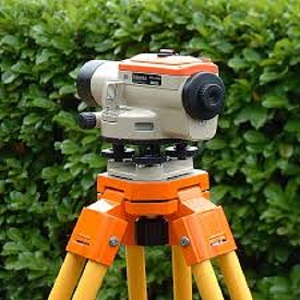Rise and fall method
The rise and fall method is a technique used in surveying to determine the difference in elevation between two points. It is commonly used in design and construction to create accurate site plans.
A levelling instrument such as a dumpy level or a theodolite is set up at one point (the benchmark) and a staff is placed at a point whose elevation is to be determined. The instrument is then sighted on the staff and the vertical distance between the instrument and the staff is measured. This is known as the backsight.
The staff is then moved to the next point and the instrument is sighted on the staff again. The vertical distance between the instrument and the staff is measured once more, and this is known as the foresight.
If the foresight is higher than the backsight, it means that the point being surveyed is higher than the benchmark. The difference between the foresight and the backsight is known as the rise. If the foresight is lower than the backsight, it means that the point being surveyed is lower than the benchmark. The difference between the backsight and the foresight is known as the fall.
The process is repeated for multiple points, with the rise and fall measurements being added and subtracted as appropriate.
[edit] Related articles on Designing Buildings
Featured articles and news
The UK's Modern Industrial Strategy: A 10 year plan
Previous consultation criticism, current key elements and general support with some persisting reservations.
Building Safety Regulator reforms
New roles, new staff and a new fast track service pave the way for a single construction regulator.
Architectural Technologist CPDs and Communications
CIAT CPD… and how you can do it!
Cooling centres and cool spaces
Managing extreme heat in cities by directing the public to places for heat stress relief and water sources.
Winter gardens: A brief history and warm variations
Extending the season with glass in different forms and terms.
Restoring Great Yarmouth's Winter Gardens
Transforming one of the least sustainable constructions imaginable.
Construction Skills Mission Board launch sector drive
Newly formed government and industry collaboration set strategy for recruiting an additional 100,000 construction workers a year.
New Architects Code comes into effect in September 2025
ARB Architects Code of Conduct and Practice available with ongoing consultation regarding guidance.
Welsh Skills Body (Medr) launches ambitious plan
The new skills body brings together funding and regulation of tertiary education and research for the devolved nation.
Paul Gandy FCIOB announced as next CIOB President
Former Tilbury Douglas CEO takes helm.
UK Infrastructure: A 10 Year Strategy. In brief with reactions
With the National Infrastructure and Service Transformation Authority (NISTA).
Ebenezer Howard: inventor of the garden city. Book review.
The Grenfell Tower fire, eight years on
A time to pause and reflect as Dubai tower block fire reported just before anniversary.
Airtightness Topic Guide BSRIA TG 27/2025
Explaining the basics of airtightness, what it is, why it's important, when it's required and how it's carried out.
Construction contract awards hit lowest point of 2025
Plummeting for second consecutive month, intensifying concerns for housing and infrastructure goals.
Understanding Mental Health in the Built Environment 2025
Examining the state of mental health in construction, shedding light on levels of stress, anxiety and depression.























Comments
[edit] To make a comment about this article, or to suggest changes, click 'Add a comment' above. Separate your comments from any existing comments by inserting a horizontal line.